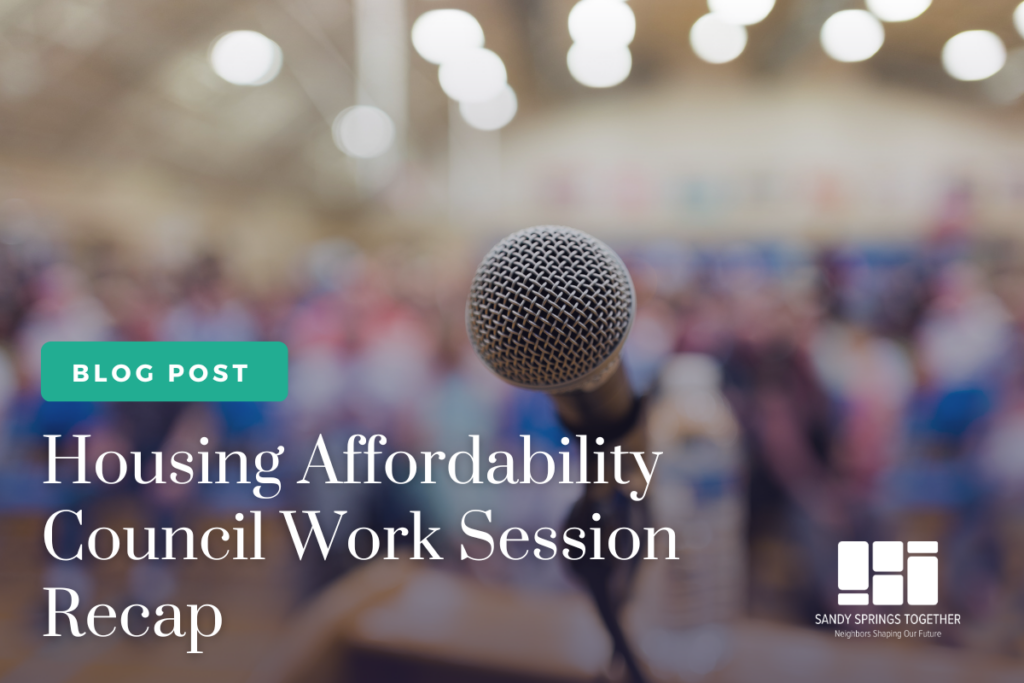
At the heart of Sandy Springs Together’s mission and values is the pillar of Affordable Housing. We believe that affordable housing supports a sustainable economic model and allows neighbors at all income levels to dwell together and contribute to not only a diverse economy but also to promote innovative growth.
On July 16, 2024, Georgia Tech student, Mira Coffman, presented her research paper on Homeownership Assessment in Sandy Springs to the Sandy Springs Mayor and City Council. The city contracted with Ms. Coffman to conduct this applied research thesis as a candidate for a master’s degree in city and regional planning from the university. Coffman was directed by the city to focus her research on homeownership opportunities city-wide but especially for young adults and families to become homeowners in Sandy Springs. The study included factors such as age, race, income, mortgage originations and denials, and comparative data from 2018 and 2022, respectively. The study did not include housing options for older residents who would like to “downsize.” In addition, the study included recommendations for changes in our land use, zoning, flexibility of development codes to allow for a variety of home types and the use of federal funds. Sources of data included ACS (American Community Survey) and HMDA (Home Mortgage Disclosure Act).
While Sandy Springs encompasses a large (and majority) renter population, the study focused on the affordability of homeownership, particularly for young families and professionals. Currently, 56% of renters with incomes between $50K-$75K are cost-burdened, spending more than 30% of their income on rent. Two additional factors make it difficult for young people in Sandy Springs in this income range to become homeowners; being cost-burdened makes it difficult for young people to save for a downpayment, and the median home price in Sandy Springs is $649,000 making the availability of homes in their price range scarce.
Coffman also emphasized that the number of occupied rental units has declined by 7,640 units since 2018 and increased owner-occupied units by 6055 . Coffman cautioned the city to take this decline seriously because a city needs to offer housing for all income levels to be sustainable in the long term.
The study also included an analysis of mortgage approvals and denials since 2018 in Sandy Springs. There has been an increase (2%) in mortgage denials for 25 – 34-year-olds and an increase (5%) in mortgage denials for African Americans and those who reported their race as “Other” (7%). Conversely, there has been a decrease in mortgage denials for Asians (4%) and a decrease of 3% for whites.
Coffman then discussed policy ideas for future consideration, mainly around zoning and land use, to enable more creative and unique ways of creating affordable housing while also still highlighting the conservation of existing neighborhoods.
Recommendations included:
- Extending development flexibility for Residential Urban districts to a greater area of the city.
- Expanding the coverage of Residential Detached and Residential Urban districts as much as possible.
- Conservation of current Subdivisions
- Reviewing Lot Sizes to encourage more affordable homes.
- Long Term Affordability
- Develop institutional capacity to leverage federal funding for affordable rental units and owner-occupied units. Mentioned HOME and CHIP partnership programs to build affordable housing with support from the federal government.
- Opportunities for down payment assistance.
At the end of the presentation, Councilman Bauman asked, “What is an appropriate definition of affordable housing in Sandy Springs for a first-time home buyer? And, can Sandy Springs have a different definition than a city 30 miles outside of ATL?” Coffman advised that she did not formulate an opinion of how Sandy Springs should define affordable housing but did say, “For the sustainability of a city, you really do need people of different income ranges who are providing different services in the city, so I think it is quite important to provide a diverse array of housing products.”
Coffman ended her presentation by saying that the rental cost burden, coupled with the loss of renters, increased median home prices and the increase in homeownership at the higher prices, points to the need for the city to consider more urgent strategic planning around affordable housing that young workers and families need vs. long-term visioning.
The full live stream of the of full presentation here: City Council Work Session • Sandy Springs Public Meetings • CivicClerk


